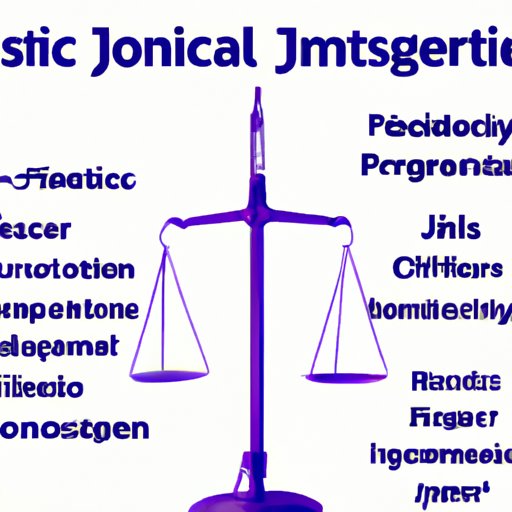Introduction
Forensic science is a field of study that focuses on the application of scientific principles to legal matters. It has become an essential part of criminal justice, as it helps to identify, analyze, and interpret physical evidence in order to provide answers to questions related to criminal cases. Forensic science is used to aid police investigations, to determine guilt or innocence in a court of law, and to provide expert testimony in criminal proceedings.
The use of forensic science in criminal justice is based on the examination of various types of evidence. Physical evidence includes objects such as weapons, clothing, fingerprints, and blood stains. Biological evidence includes human remains, hair, and bodily fluids. Chemical evidence includes drug residue, paint chips, and accelerants. Digital evidence includes computer files, emails, and other digital media.

Branches of Forensic Science and Their Significance
Physical evidence is any object or material found at a crime scene that can be used to link a suspect to the crime. Examples include fingerprints, footprints, tire tracks, and tool marks. This type of evidence is typically collected and analyzed by forensic scientists to determine if it is associated with a particular individual or event.
Biological evidence is any material that contains genetic information, such as blood, saliva, semen, and tissue samples. This type of evidence is used to establish a person’s identity, or to determine their involvement in a crime. DNA profiling, which uses a sample of DNA to identify an individual, has become an increasingly important tool for forensic scientists in recent years.
Chemical evidence is any material that can be used to determine the chemical composition of a substance or object. Examples include drugs, explosives, and paint chips. Chemical evidence can be used to establish a link between a suspect and a crime scene, or to determine the cause of death in a homicide investigation.
Digital evidence is any data stored on a computer or other electronic device. This type of evidence is often used to establish a suspect’s involvement in a crime, or to prove the existence of a particular transaction. Digital evidence can include emails, text messages, photos, videos, and other digital media.
Impact of New Technologies on Forensic Science
New technologies have had a significant impact on the field of forensic science. Automation is one of the most significant developments, as it has allowed for the faster and more accurate processing of evidence. DNA profiling has also revolutionized the field, as it allows for the identification of individuals using only a small sample of DNA.
Robotics is another technological advancement that has had a major impact on forensic science. Robotic systems are now being used to collect and analyze evidence in crime scenes, thus reducing the amount of time and resources needed for investigations. These robots are also able to detect and analyze evidence that would otherwise be difficult or impossible to find.

How Forensic Science Has Changed Criminal Justice Procedures
The introduction of forensic science into criminal justice procedures has had a profound effect on the way cases are investigated and prosecuted. The improved accuracy of evidence collection and analysis has led to more successful prosecutions, as prosecutors are able to present stronger cases in court. The increased efficiency of evidence analysis has also enabled prosecutors to process more cases in less time.
In addition, the expanded use of expert witnesses in court proceedings has allowed for more reliable and accurate testimony. Expert witnesses are able to explain complex scientific concepts to juries, thus helping them better understand the evidence presented in a case.
Challenges Faced by Forensic Scientists in Criminal Cases
Despite the many advances in forensic science, there are still several challenges that forensic scientists face when dealing with criminal cases. One of the biggest challenges is the lack of standardization in the field. Different laboratories may use different techniques and protocols, making it difficult to compare results from different facilities.
Another challenge is the shortage of funds available for forensic science research and training. With limited resources, laboratories are unable to purchase the latest equipment or hire qualified personnel. This can lead to mistakes and unreliable results, which can have serious consequences in criminal cases.
Finally, forensic scientists often face a lack of access to resources. This can include a lack of access to databases or other sources of information that could help with investigations. In some cases, a lack of access to certain types of evidence can make it difficult to reach a conclusion.

Comparison of Forensic Science with Other Fields in Criminal Justice
Forensic science is similar to other fields in criminal justice in that it involves the use of scientific methods to investigate and analyze evidence. However, there are some key differences between forensic science and other disciplines within the criminal justice system. For example, forensic science relies heavily on laboratory analysis, while other disciplines may rely more on eyewitness accounts or interviews.
Another difference between forensic science and other criminal justice disciplines is the amount of time and resources needed to complete an investigation. Forensic investigations often require extensive laboratory testing, while other disciplines may be able to reach a conclusion with fewer resources. Additionally, forensic science requires highly trained personnel, while other disciplines may not have such stringent requirements.
Conclusion
Forensic science plays an important role in criminal justice, as it helps to identify, analyze, and interpret physical evidence in order to provide answers to questions related to criminal cases. New technologies, such as automation and DNA profiling, have revolutionized the field, leading to improved accuracy and efficiency of evidence collection and analysis. However, forensic scientists still face challenges, such as a lack of standardization, shortage of funds, and limited access to resources.
Overall, forensic science has changed the way criminal justice procedures are conducted. Improved accuracy of evidence collection and analysis, increased efficiency of evidence analysis, and the expanded use of expert witnesses in court proceedings have all had a positive impact on the criminal justice system. Although there are similarities between forensic science and other criminal justice disciplines, there are also some key differences, such as the amount of time and resources needed to complete an investigation.
(Note: Is this article not meeting your expectations? Do you have knowledge or insights to share? Unlock new opportunities and expand your reach by joining our authors team. Click Registration to join us and share your expertise with our readers.)
